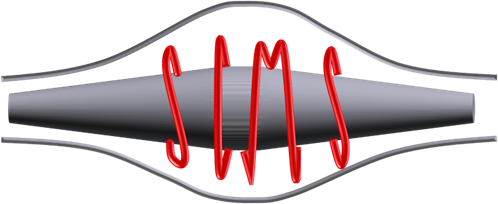 In 2017, NPL and collaborators introduced OrbiSIMS, bringing the mass spectrometry (MS) performance found in high-end proteomics laboratories to UHV surface and interface analysis studies at the micro (spatial) and nanoscale (depth). OrbiSIMS, uses a hybrid approach where the high mass resolution of an Orbitrap MS, but slow speed, complements the high-speed, but low mass spectrometry performance, of a time-of-flight (ToF) MS. OrbiSIMS was originally designed for single-cell metabolomic studies to reduce drug attrition and improve drug efficacy in pharmaceutical research and development. Since then, it has been successfully commercialised and many instruments around the world in academia and industry are being used in ground breaking studies in a diverse range of applications including pharmaceutical discovery, delivery and manufacturing, cancer biology, nutrition, medical devices, organic electronics and semiconductors.
In 2017, NPL and collaborators introduced OrbiSIMS, bringing the mass spectrometry (MS) performance found in high-end proteomics laboratories to UHV surface and interface analysis studies at the micro (spatial) and nanoscale (depth). OrbiSIMS, uses a hybrid approach where the high mass resolution of an Orbitrap MS, but slow speed, complements the high-speed, but low mass spectrometry performance, of a time-of-flight (ToF) MS. OrbiSIMS was originally designed for single-cell metabolomic studies to reduce drug attrition and improve drug efficacy in pharmaceutical research and development. Since then, it has been successfully commercialised and many instruments around the world in academia and industry are being used in ground breaking studies in a diverse range of applications including pharmaceutical discovery, delivery and manufacturing, cancer biology, nutrition, medical devices, organic electronics and semiconductors.
We recently developed CryoOrbiSIMS which allows 3D imaging of biological materials in their native state. This is having important benefits in the life-sciences.
Reproduced from (https://www.nature.com/articles/nmeth.4504): Comparison of resolving power of ToF MS (black) and Orbitrap MS (red) for intact lipids from mouse hippocampus. Negative ion mass spectra between m/z 902 – m/z 910 (red = Orbitrap MS (mode 2), black = ToF MS (mode 1)) and Detail of spectra between m/z 904.2 – m/z 905.0.
There is a general analytical challenge in measuring chemistry at surfaces and interfaces. While we can use bulk techniques like nuclear magnetic resonance (NMR) and liquid chromatography – mass spectrometry (LC-MS) and have high confidence in what a molecule is, we have limited information on its localisation. Alternatively, we can have high-confidence in the localisation, for example following an isotopic label with NanoSIMS, but low confidence in the molecule identification. We call this the ‘molecular uncertainty principle’. This is a major analytical problem as many scientific and technological advances require knowledge of the molecular identity and precise location.
In pharmaceutical research and development there is a concerted effort to reduce the number of candidate drugs that fail at late stage, known as drug attrition. Since most of the cost of drug development is in the final phases (pre-clinical and clinical studies) of a decade long process, spotting early signals of failure can result in big savings and focus resources on candidates that have more chance of becoming a medicine. The industry strategy is based generally around the so-called Pfizer three pillars:
Sir Colin Dollery FMedSci, senior Consultant at GSK, had identified the need to measure where in a cell the drug is and with high-confidence that the molecule detected is the drug in question. This is a classic example of the general ‘molecular uncertainty principle’ problem. Sir Colin had heard about the work on mass spectrometry imaging that we were doing at NPL and visited in 2012 to find out more. Coincidently, at that time Professor Ian Gilmore FMedSci had been thinking about this general problem and how it might be overcome.
In 2012, Ian had a radical idea to create a new instrument that combines the high-spatial resolution imaging of secondary ion mass spectrometry (SIMS) with the high-mass resolution of an Orbitrap mass spectrometer, achieving unprecedented chemical resolution. He led a multidisciplinary team with experts in drug discovery at GSK, pharmaceutical science at the University of Nottingham and leading mass spectrometry companies, IONTOF and Thermo Fisher Scientific who designed and integrated their technologies into a single platform, the OrbiSIMS.
The instrument was launched by Sir Colin Dollery FMedSci at NPL in November 2016 and was first published in 2017. In that landmark paper, we demonstrated metabolic imaging with a spatial resolution of 1.4 μm simultaneously with a mass resolving power of over 200,000 at m/z 200 and with MS/MS capability. We also demonstrated spatially resolved single-cell metabolomic profiling, revealing the hitherto unknown wide variation in drug uptake between ‘identical’ cells and that, cell-by-cell, the drug accumulation correlates with up-regulation of key metabolites. Imaging with < 200 nm with the same high-mass resolving power was also demonstrated for nanofibers as well as the ability for nanoscale interfacial analysis with LC-MS quality spectra.
Through Cancer Research UK's Grand Challenge programme, NPL's Professor Josephine Bunch leads a team of multidisciplinary chemists, physicists and biologists from across the UK. We deliver new insights which have the potential to revolutionise our understanding of cancer and pioneer more effective treatments.
NPL’s OrbiSIMS project was widely disseminated through three NPL press releases (2012, 2017 and 2019) and featured in several wider-readership magazines including:
Our research and measurement solutions support innovation and product development. We work with companies to deliver business advantage and commercial success.
Contact our Customer Services team on +44 20 8943 7070